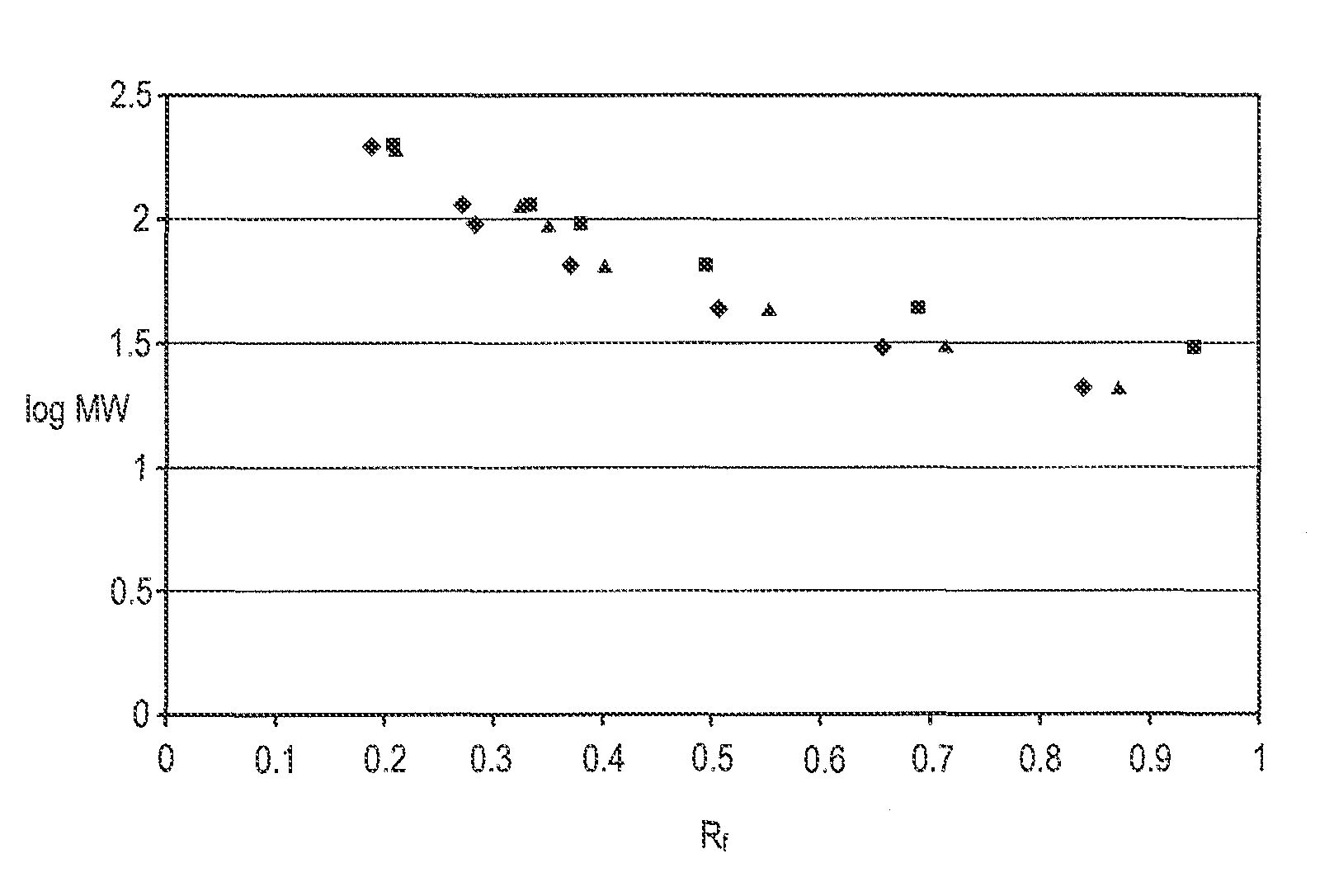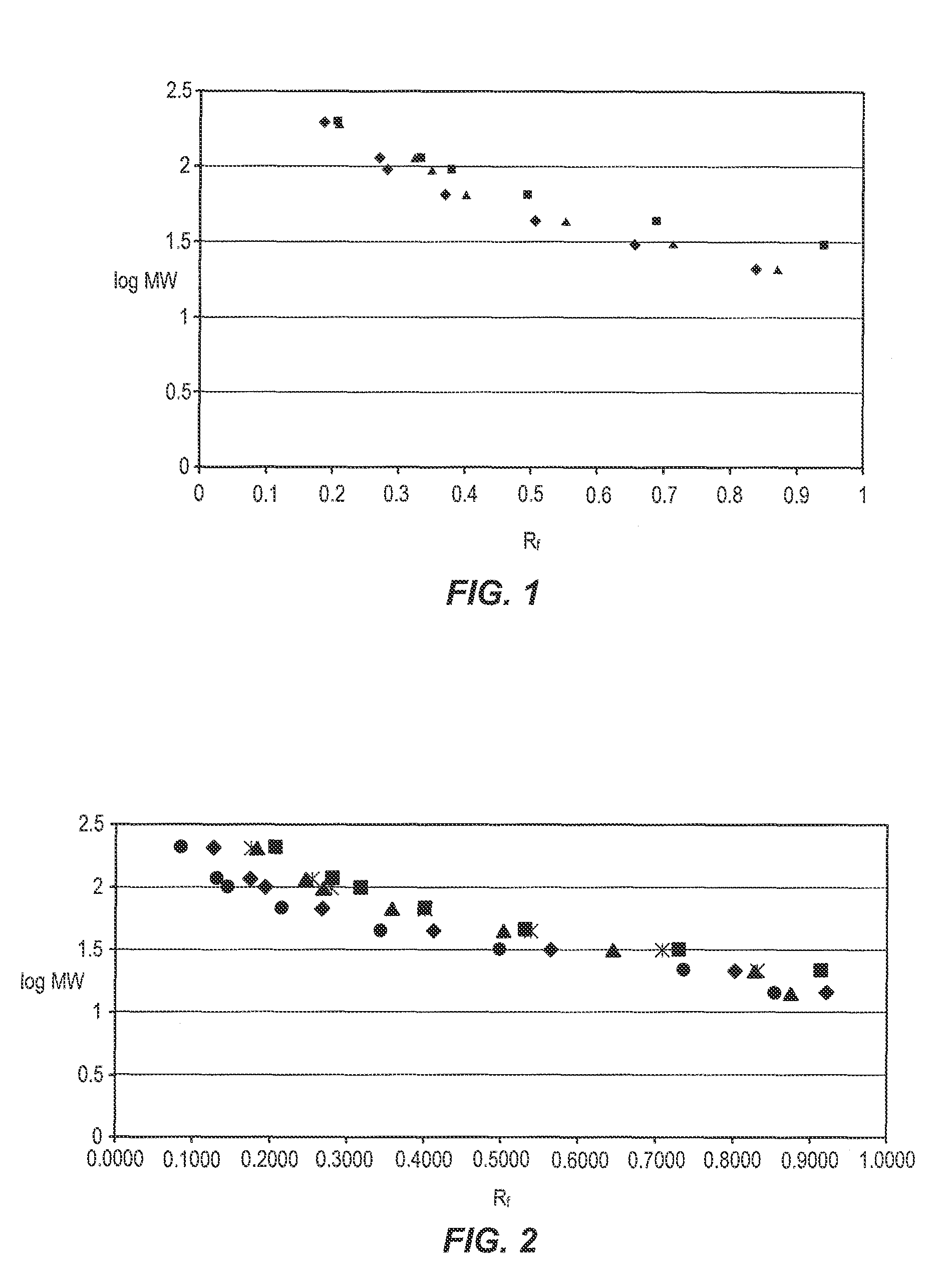Hydrolysis-resistant polyacrylamide gels
a polyacrylamide gel and hydrolysis technology, applied in the direction of fluid pressure measurement, liquid/fluent solid measurement, peptides, etc., can solve the problems of less clear separation of proteins by gels, inability to obtain useful analysis of protein mixtures, and gel hydrolysis, so as to achieve no significant loss of resolution, improve band resolution, and function effectively
- Summary
- Abstract
- Description
- Claims
- Application Information
AI Technical Summary
Benefits of technology
Problems solved by technology
Method used
Image
Examples
example 1
[0014]This example compares the performance of polyacrylamide gels prepared with triethanolamine within the scope of the invention with a polyacrylamide gel prepared with Tris-HCl and thus outside the scope of the invention in electrophoretic separations. The separations were performed the same day the gels were prepared.
[0015]A series of polyacrylamide gels were cast in slab gel electrophoresis cassettes using a 10% aqueous acrylamide / bis-acrylamide solution (T=10%) of which the bis-acrylamide constituted 2.6% of the monomer mixture (C=2.6%). Also included in the casting solutions were 5% glycerol and sufficient HCl to adjust the pH to 6.4-6.5. The control solution further included 10 mole % Tris-HCl, while the test solutions included 75 mM triethanolamine plus either 82.6 mM asparagine, 82.6 mM glycyl glycine, or 82.6 mM glycyl glycine in combination with 100 mM MES. None of the test solutions contained Tris-HCl. A standard protein mixture was run on all gels, using a Ready Gel ca...
example 2
[0017]This example illustrates the performance of polyacrylamide gels within the scope of the invention containing asparagine and glycine, each at various concentrations. Electrophoretic separations were performed on the gels the same day the gels were prepared.
[0018]The monomer compositions of the gel solutions were T=10% and C=2.6%, the same as in Example 1, and the remaining components of the solutions were as follows, where TEA denotes triethyanolamine, ASN denotes asparagine, and GLY denotes glycine:
[0019]
GelComposition (in addition to acrylamide / bis-acrylamide)(A)150 mM TEA; 86.5 mM ASN(B)150 mM TEA; 5 mM ASN(C)150 mM TEA; 5 mM ASN; 5 mM GLY(D)150 mM TEA; 5 mM ASN; 12.5 mM GLY(E)150 mM TEA; 5 mM ASN; 50 mM GLY(F)150 mM TEA; 5 mM ASN; 75 mM GLY(G)150 mM TEA; 5 mM ASN; 100 mM GLY
[0020]The standard protein mixture was run on all gels and a comparison of the resulting electropherograms revealed that there was no loss in band resolution and distribution by using the lower rather th...
example 3
[0024]This example is a further illustration of the effects of using triethanolamine in combination with varying the concentrations of asparagine and glycine, all within the scope of the invention and without Tris-HCl. Tests were performed on the gels the same day the gels were prepared.
[0025]Using the same monomer compositions as those of Example 1, the remaining components of the solutions were as follows (using the abbreviations indicated above):
[0026]
GelComposition (in addition to acrylamide / bis-acrylamide)(A)75 mM TEA; 83 mM ASN(B)75 mM TEA; 12.5 mM ASN; 100 mM GLY(C)75 mM TEA; 25 mM ASN; 100 mM GLY(D)75 mM TEA; 50 mM ASN; 100 mM GLY(E)75 mM TEA; plus 75 mM ASN; 100 mM GLY
[0027]The standard protein mixture was run on all gels and a comparison of the resulting electropherograms revealed that band resolution and distribution was achieved in all cases.
PUM
| Property | Measurement | Unit |
|---|---|---|
| voltage | aaaaa | aaaaa |
| voltage | aaaaa | aaaaa |
| pKa | aaaaa | aaaaa |
Abstract
Description
Claims
Application Information
 Login to View More
Login to View More - R&D
- Intellectual Property
- Life Sciences
- Materials
- Tech Scout
- Unparalleled Data Quality
- Higher Quality Content
- 60% Fewer Hallucinations
Browse by: Latest US Patents, China's latest patents, Technical Efficacy Thesaurus, Application Domain, Technology Topic, Popular Technical Reports.
© 2025 PatSnap. All rights reserved.Legal|Privacy policy|Modern Slavery Act Transparency Statement|Sitemap|About US| Contact US: help@patsnap.com


